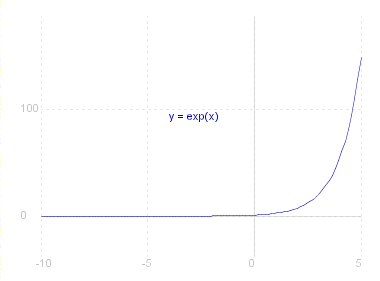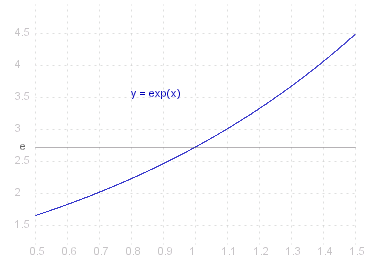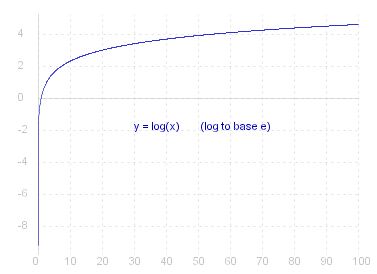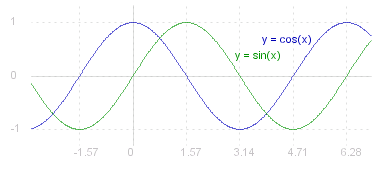Exponential and Circular Functions
Exponential Function
Derivative of the Exponential Function
Define
exp ~x _ = _ f ( ~x ) _ = _ sum{fract{~x^~n,~n#!},~n = 0,&infty.}
Given ~a , _ select ~K _ such that _ ~K > | ~a | . _ Then
f ( ~x ) - f ( ~a ) _ = _ sum{fract{~x^~n - ~a^~n,~n#!},~n = 0,&infty.}
Note that
~x^~n - ~a^~n _ = _ ( ~x - ~a ) sum{~x^{~n - 1 - ~i} ~a^~i,~i = 0,~n - 1}
So
f ( ~x ) - f ( ~a ) _ = _ ( ~x - ~a ) sum{fract{1,~n#!} sum{~x^{~n - 1 - ~i} ~a^~i,~i = 0,~n - 1},~n = 0,&infty.}
Now
abs{ fract{1,~n#!} sum{ ~x^{~n - 1 - ~i} ~a^~i ,~i = 0,&infty.}} _ _ =< _ _ ~n fract{~K^{~n-1}, ~n#!} _ = _ fract{~K^{~n-1}, (~n - 1)#!}
( for _ | ~x | =< ~K ). _ So
sum{fract{1,~n#!} rndb{sum{ ~x^{~n - 1 - ~i} ~a^~i ,~i = 0,~n - 1}},~n = 1,&infty.}
is uniformly convergend by Weirstrass' M-test, with _ ~M_~n _ = _ ~K^{~n - 1} / (~n - 1)#!
All terms are polynomials and therefore continuous. So
f '( ~a ) _ = _ sum{fract{1,~n#!} rndb{sum{ ~a^{~n - 1} ,~i = 0,~n - 1}},~n = 1,&infty.}
_ = _ sum{fract{1,(~n-1)#!} ~a^{~n - 1} ,~n = 1,&infty.} _ = _ f ( ~a )
So
| (1) _ _ _ _ _ D exp ~x _ = _ exp ~x (2) _ _ _ _ _ exp 0 _ = _ 1 |
Consider _ g ( ~x ) _ = _ exp ~x exp ( ~c - ~x ) , _ any ~c &in. &reals. , _ then
_ _ _ _ _ g '( ~x ) _ = _ exp ~x exp ( ~c - ~x ) - exp ~x exp ( ~c - ~x ) _ == _ 0 .
So _ g ( ~x ) _ = _ ~K _ (constant). _ In particular _ g(0) = ~k , _ but _ g(0) _ = _ exp ~c , _ so
_ _ _ _ _ exp ~x exp ( ~c - ~x ) _ = _ exp ~c , _ &forall. ~x .
Therefore for any arbitrary real numbers, ~a, ~b, putting ~c = ~a + ~b, ~x = ~a, _ we have:
| (3) _ _ _ _ _ exp ~a exp ~b _ = _ exp ( ~a + ~b ) |
Let ~e denote the real number _ ~e _ = _ exp 1 . _ then (3) =>
| (4) _ _ _ _ _ exp ~n _ = _ ~e^~n |
The exponential function is continuous (from (1)) and (3) =>
| (5) _ _ _ _ _ exp ~x exp -~x _ = _ exp 0 _ = _ 1 (6) _ _ _ _ _ exp -~x _ = _ 1 / exp ~x |
this implies that _ exp ~x != 0 , _ for any ~x , _ but exp (0) = 1 , _ so by the intermediate value theorem:
| (7) _ _ _ _ _ exp ~x _ > _ 0 , _ _ &forall. ~x &in. &reals. |
(1) => exp ~x is strictly increasing and (4) => _ exp _ not bounded above, so
| (8) _ _ _ _ _ exp ~x _ -> _ &infty. , _ _ as _ ~x _ -> _ &infty. (9) _ _ _ _ _ exp ~x _ -> _ 0 , _ _ as _ ~x _ -> _ -&infty. |
[ (9) follows from (6). ]


Logarithmic Function
We have seen that _ exp ~x _ is a strictly increasing non-zero continuous function, so it has an inverse function. Put
| (10) _ _ _ _ _ ~x = log ~y _ <=> _ ~y = exp ~x , _ _ ~y &in. &reals.^+ (11) _ _ _ _ _ log exp ~x _ = _ ~x , _ _ exp log ~y _ = _ ~y |

By inverse function theorem : _ D log ~y _ = _ 1 / D exp ~x _ = _ 1 / exp ~x _ = _ 1 / ~y .
| (12) _ _ _ _ _ D log ~y _ = _ 1 / ~y |
~x = log ~p , and ~y = log ~q _ <=> _ ~p = exp ~x , and ~q = exp ~y _ so _ ~p~q = exp ~x exp ~y = exp ( ~x + ~y ) _ by (3), so
| (13) _ _ _ _ _ log ~p~q _ = _ log ~p + log ~q |
In particular
| (14) _ _ _ _ _ log ~p^~n _ = _ ~n log ~p , _ _ for ~n &in. &naturals. |
So _ ~p^~n _ = _ exp ( ~n log ~p ). _ For any ~a &in. &reals.^+, _ ~b &in. &reals. _ define
| (15) _ _ _ _ _ ~a^~b _ #:= _ exp ( ~b log ~a ) |
This is consistent with the result for natural numbers, and
~a^{~b + ~c} _ = _ exp ( ( ~b + ~c ) log ~a ) _ = _ exp ( ~b log ~a + ~c log ~a ) _ = _ exp ( ~b log ~a ) exp ( ~c log ~a ) _ = _ ~a^~b ~a^~c
| (16) _ _ _ _ _ ~a^{~b + ~c} _ = _ ~a^~b ~a^~c |
Now _ D ~x^~a = D ( exp ( ~a log ~x ) ) = ( ~a / ~x ) exp ( ~a log ~x ) = ( ~a / ~x ) ~x^~a _ _ i.e
| (17) _ _ _ _ _ D ~x^~a = ~a ~x^{~a - 1} |
D ~a^~x = D exp ( ~x log ~a) = exp ( ~x log ~a) log ~a = ~a^~x log ~a
| (18) _ _ _ _ _ D ~a^~x = ~a^~x log ~a |
Circular Functions
We define the #~{circular} or #~{trigonometric} funtions #~{cosine} (cos) and #~{sine} (sin) as follows
cos ~x _ = _ sum{( -1 )^~n fract{~x^{2~n},2~n#!},~n = 0,&infty.} _ = _ 1 - fract{~x^2,2#!} + fract{~x^4,4#!} + ... _ , _ ~x &in. &reals.
sin ~x _ = _ sum{( -1 )^~n fract{~x^{2~n + 1},(2~n + 1)#!},~n = 0,&infty.} _ = _ ~x - fract{~x^3,3#!} + fract{~x^5,5#!} + ... _ , _ ~x &in. &reals.
both are absolutely convergent &forall. ~x &in. &reals..
D cos ~x _ = _ sum{( -1 )^~n fract{~x^{2~n - 1},(2~n - 1)#!},~n = 1,&infty.}
_ = _ sum{( -1 )^~m fract{~x^{2~m + 1},(2~m + 1)#!},~m = 0,&infty.} _ = _ -sin ~x
and similarly for sin ~x , _ i.e.
| (19) _ _ _ _ _ D cos ~x _ = _ -sin ~x (20) _ _ _ _ _ D sin ~x _ = _ cos ~x (21) _ _ _ _ _ cos 0 _ = _ 1 , _ _ sin 0 _ = _ 0 |
Consider _ f ( ~x ) _ = _ cos^2 ~x + sin^2 ~x _ ( note: cos^2 ~x = ( cos ~x )^2 ).
f '( ~x ) _ = _ - 2 cos ~x sin ~x + 2 sin ~x cos ~x _ = _ 0 _ => _ f ( ~x ) = constant,
but _ f ( 0 ) _ = _ 1 _ =>
| (22) _ _ _ _ _ cos^2 ~x + sin^2 ~x _ = _ 1 , _ _ &forall. ~x &in. &reals. (23) _ _ _ _ _ | cos ~x | _ < _ 1 , _ _ | sin ~x | _ < _ 1 |
Consider _ g ( ~x ) = cos ~x cos ( ~c - ~x ) - sin ~x sin ( ~c - ~x ) , _ some ~c &in. &reals.
g '( ~x ) _ = _ - sin ~x cos ( ~c - ~x ) + cos ~x sin ( ~c - ~x ) - cos ~x sin ( ~c - ~x ) + sin ~x cos ( ~c - ~x ) _ = _ 0 so _ g ( ~x ) _ is constant, but g ( 0 ) = cos ~c , _ &forall. ~c , ~x &in. &reals.. Put _ ~c = ~a + ~b , _ ~x = ~a , _ arbitrary ~a , ~b &in. &reals., then
| (24) _ _ _ _ _ cos ( ~a + ~b ) _ = _ cos ~a cos ~b - sin ~a sin ~b |
Differentiating with respect to ~a :
| (25) _ _ _ _ _ sin ( ~a + ~b ) _ = _ sin ~a cos ~b + cos ~a sin ~b |
In particular:
| (26) _ _ _ _ _ cos 2~a _ = _ cos^2 ~a - sin^2 ~a (27) _ _ _ _ _ sin 2~a _ = _ 2 sin ~a cos ~a |
Periodicity
Now
cos 2 _ = _ 1 - fract{2^2,2#!} + fract{2^4,4#!} - fract{2^6,6#!} + fract{2^8,8#!} + ...
_ = _ 1 - 2 + fract{2,3} - fract{2^6,6#!} rndb{1 - fract{2 # 6#!,8#!}} - fract{2^{10},10#!} rndb{1 - fract{2 # 10#!,12#!}} ...
=> cos 2 < 0 _ , but cos 0 = 1 , _ and cos ( ~x ) is continuous, so
| (28) _ _ &exist. ~k &in. ( 0 , 2 ) _ such that _ cos ~k _ = _ 0 |
sin ~x _ = _ ~xrndb{1 - fract{~x^2,3 # 2}} + fract{~x^5,5#!}rndb{~1 - fract{~x^2,7 # 6}} + ...
sin ~x > 0 , _ &forall. ~x &in. ( 0 , 2 ) , _ &therefore. _ D cos ~x = - sin ~x _ < 0 _ &forall. ~x &in. ( 0 , 2 ) .
So _ cos ~x _ is strictly decreasing in ( 0 , 2 ) _ => _ &exist. unique ~k &in. ( 0 , 2 ) _ such that _ cos ~k = 0 .
Now _ sin^2 ~k = 1 - cos^2 ~k _ => _ sin ~k = +- 1 , _ but _ sin ~x > 0 , _ ~x &in. [ 0 , 2 ] , _ so _ .
| (29) _ _ _ _ _ sin ~k _ = _ 1 (30) _ _ _ _ _ sin ( ~x + ~k ) _ = _ sin ~x cos ~k + cos ~x sin ~k _ = _ cos ~x _ _ _ _ _ _ _ _ _ _ cos ( ~x + ~k ) _ = _ cos ~x cos ~k - sin ~x sin ~k _ = _ - sin ~x (31) _ _ _ _ _ cos 2~k _ = _ -1 , _ sin 2~k _ = _ 0 , _ cos 4~k _ = _ 1 , _ sin 4 ~k _ = _ 0 (32) _ _ _ _ _ cos ( ~x + 4~k ) _ = _ cos ~x , sin ( ~x + 4~k ) _ = _ sin ~x |
Thus the funtions _ sin ( ~x ) _ and _ cos ( ~x ) are periodic with period 4~k ( = 2 &pi. ).

Source for the graphs shown on this page can be viewed by going to the diagram capture page .